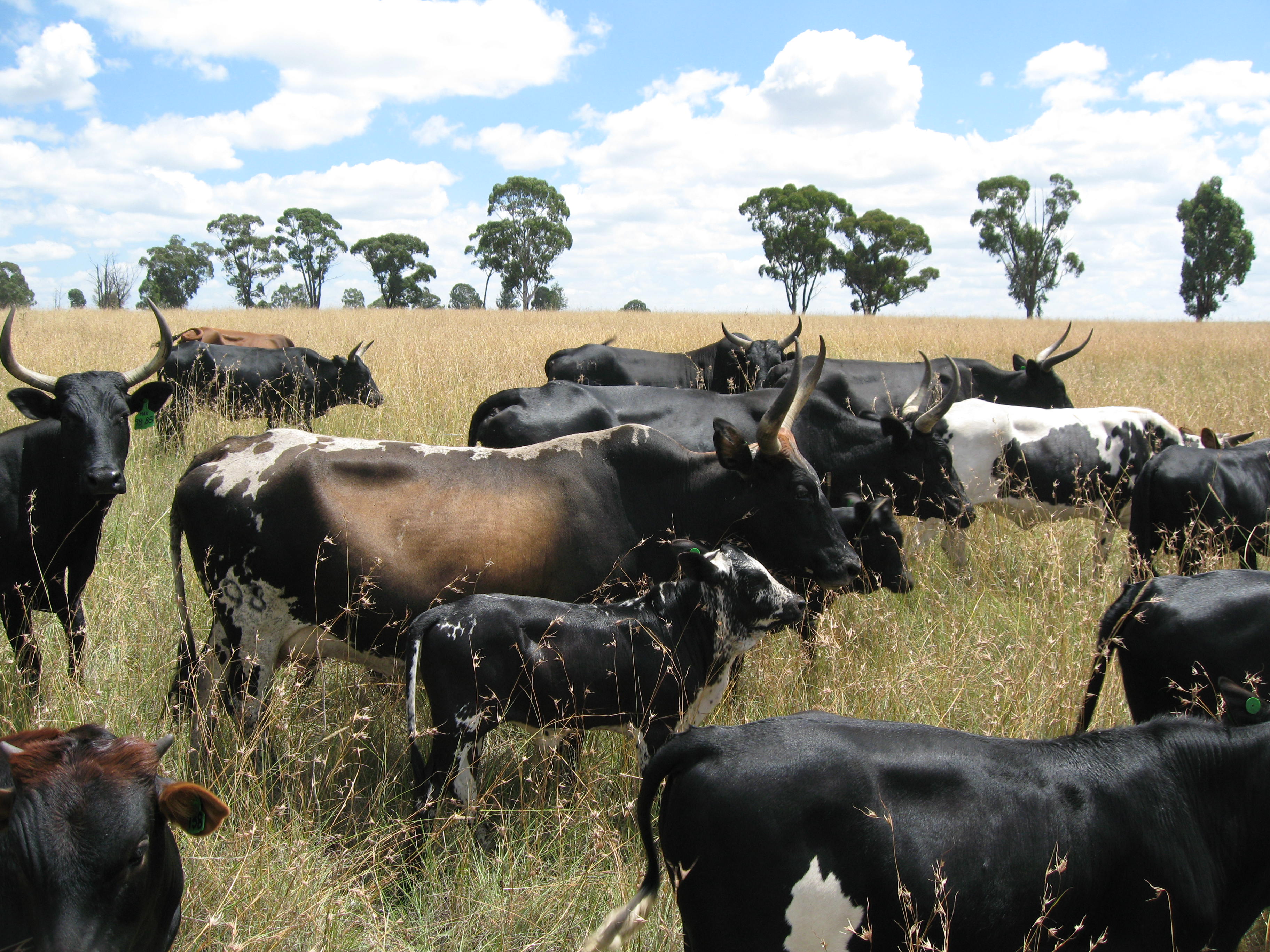Nguni cattle on:
[Wikipedia]
[Google]
[Amazon]
 The Nguni is a cattle breed indigenous to
The Nguni is a cattle breed indigenous to
 The Nguni is a cattle breed indigenous to
The Nguni is a cattle breed indigenous to Southern Africa
Southern Africa is the southernmost subregion of the African continent, south of the Congo and Tanzania. The physical location is the large part of Africa to the south of the extensive Congo River basin. Southern Africa is home to a number o ...
. A hybrid of different Indian and later European cattle breeds, they were introduced by pastoralist tribes ancestral to modern Nguni people to Southern Africa during their migration from the North
North is one of the four compass points or cardinal directions. It is the opposite of south and is perpendicular to east and west. ''North'' is a noun, adjective, or adverb indicating direction or geography.
Etymology
The word ''north ...
of the continent.
The cattle breed is medium-sized and adapted to grazing on the highveld.
Characteristics
Ngunicattle
Cattle (''Bos taurus'') are large, domesticated, cloven-hooved, herbivores. They are a prominent modern member of the subfamily Bovinae and the most widespread species of the genus '' Bos''. Adult females are referred to as cows and adult ...
are known for their fertility and resistance to diseases, being the favourite breed amongst the local Bantu-speaking people of southern Africa (South Africa
South Africa, officially the Republic of South Africa (RSA), is the southernmost country in Africa. It is bounded to the south by of coastline that stretch along the South Atlantic and Indian Oceans; to the north by the neighbouring coun ...
, Eswatini
Eswatini ( ; ss, eSwatini ), officially the Kingdom of Eswatini and formerly named Swaziland ( ; officially renamed in 2018), is a landlocked country in Southern Africa. It is bordered by Mozambique to its northeast and South Africa to its no ...
, Namibia
Namibia (, ), officially the Republic of Namibia, is a country in Southern Africa. Its western border is the Atlantic Ocean. It shares land borders with Zambia and Angola to the north, Botswana to the east and South Africa to the south and ea ...
, Zimbabwe
Zimbabwe (), officially the Republic of Zimbabwe, is a landlocked country located in Southeast Africa, between the Zambezi and Limpopo Rivers, bordered by South Africa to the south, Botswana to the south-west, Zambia to the north, and ...
, Botswana
Botswana (, ), officially the Republic of Botswana ( tn, Lefatshe la Botswana, label= Setswana, ), is a landlocked country in Southern Africa. Botswana is topographically flat, with approximately 70 percent of its territory being the Kal ...
, and Angola
, national_anthem = "Angola Avante"()
, image_map =
, map_caption =
, capital = Luanda
, religion =
, religion_year = 2020
, religion_ref =
, coordinat ...
). They are characterised by their multicoloured skin, which can present many different patterns, but their noses are always black-tipped.
They are a principal form of Sanga cattle
Sanga cattle is the collective name for indigenous cattle of sub-Saharan Africa. They are sometimes identified as a subspecies with the scientific name ''Bos taurus africanus''. Their history of domestication and their origins in relation to ...
, which originated as hybrids of Zebu
The zebu (; ''Bos indicus'' or ''Bos taurus indicus''), sometimes known in the plural as indicine cattle or humped cattle, is a species or subspecies of domestic cattle originating in the Indian sub-continent. Zebu are characterised by a fatty h ...
and humpless cattle in East Africa. DNA analyses have confirmed that they are a combination of ''Bos indicus
The zebu (; ''Bos indicus'' or ''Bos taurus indicus''), sometimes known in the plural as indicine cattle or humped cattle, is a species or subspecies of domestic cattle originating in the Indian sub-continent. Zebu are characterised by a fatty h ...
'' and ''Bos taurus
Cattle (''Bos taurus'') are large, domesticated, cloven-hooved, herbivores. They are a prominent modern member of the subfamily Bovinae and the most widespread species of the genus ''Bos''. Adult females are referred to as cows and adult ma ...
'', that is a combination of different Zebu and European cattle breeds.
They are characterised by low cervicothoracic humps, in front of the front legs, instead of the high thoracic humps of pure Zebu. Besides the various colour patterns, these animals present a variety of horn shapes.
All different combinations were catalogued in the beginning of the century by a South African herdmaster. This work inspired the ''Nguni Cattle Register'', a compilation of terms to describe in full a Nguni cow or bull. The cattle are medium-sized, with bulls weighing between 500 and 600 kg, while cows weigh between 300 and 400 kg.
Origins
The ancestors of Nguni cattle were brought by ancestors of Nguni ( Zulu, Xhosa,Ndebele
Ndebele may refer to:
*Southern Ndebele people, located in South Africa
*Northern Ndebele people, located in Zimbabwe and Botswana
Languages
* Southern Ndebele language, the language of the South Ndebele
* Northern Ndebele language, the language ...
, Swazi people, etc.), during their postulated migration to the south of Africa.
See also
* Nguni shield *Cowhide
Cowhide is the natural, unbleached skin and hair of a cow. It retains the original coloring of the animal. Cowhides are a product of the food industry from cattle. Cowhide is frequently processed into leather.
Process
Once a cow has been killed ...
References
{{DEFAULTSORT:Nguni Cattle Cattle breeds Cattle breeds originating in South Africa Nguni